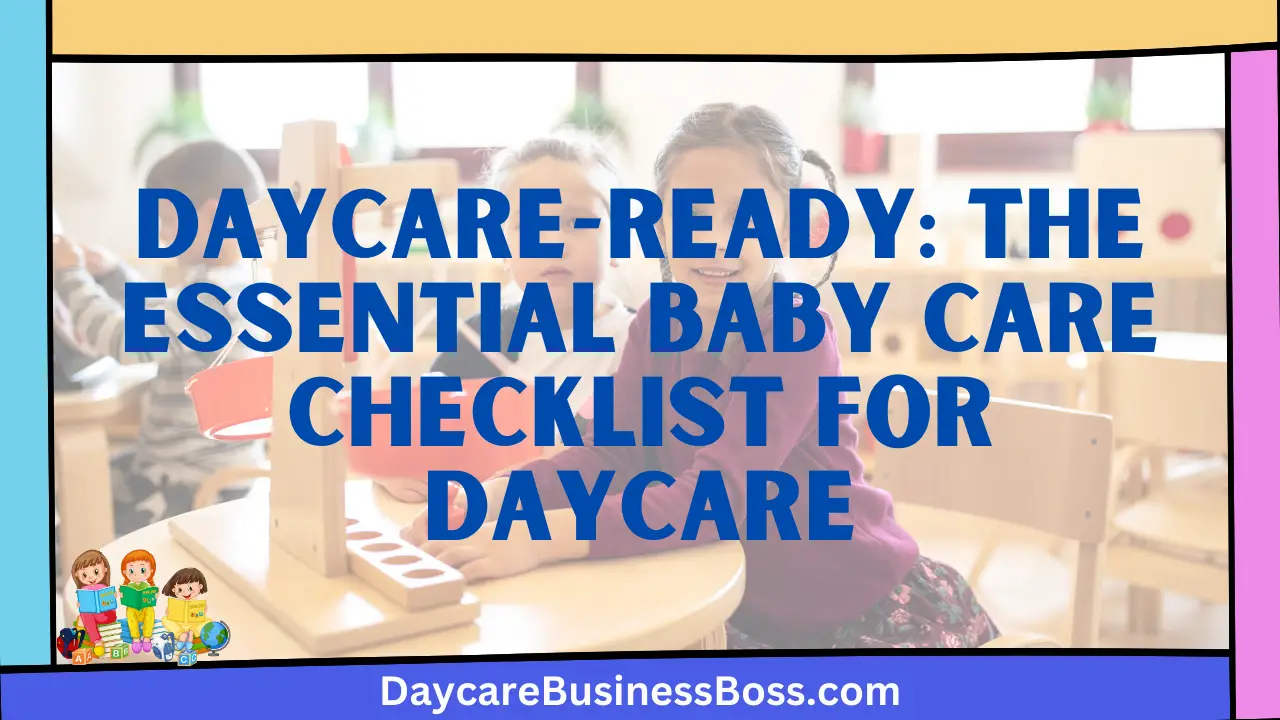Parenthood is an incredible adventure full of tremendous moments of joy, learning, and growth. Among these changing experiences is the decision by parents to leave their precious children at a daycare center. Finding the best daycare and safeguarding your baby’s comfort and safety become crucial, whether it’s for a return to work or a need for socialization.
The most useful baby daycare checklist includes essentials such as diapers, bottles, extra clothes, baby food, pacifiers, a blanket, emergency contacts, and any specific instructions for feeding and nap schedules. Safety, hygiene, and comfort items are crucial for the baby’s well-being.
In this article, we’ll go through the technicalities of creating a comprehensive infant daycare checklist, which will provide parents peace of mind that their baby’s requirements will be addressed while they’re gone. Join us as we investigate the components of an effective baby daycare checklist and uncover the key to an engaging daycare experience for both parents and their children.
Essentials for a Well-Prepared Daycare Experience

- Diapers: A large supply of diapers, as well as wipes and diaper cream, is extremely necessary. It is critical to ensure that the daycare facility has a designated changing area equipped with these essential materials. This offers a smooth diaper-changing experience for your baby, delivering both comfort and hygiene in a well-prepared atmosphere.
- Bottles: Parents of bottle-fed babies must provide an ample supply of formula or breast milk. Having an adequate supply ensures that your baby’s nutritional needs are addressed during their daycare experience. Another important step to avoid confusion is to carefully label each bottle with your baby’s name. By taking this precaution, you reduce the possibility of mix-ups and maintain the consistency of your baby’s feeding regimen, guaranteeing a smooth and nourishing experience when they’re away from home.
- Extra Clothes: Babies have an uncanny ability to make unexpected messes at any time. To be adequately prepared, bring at least two additional pieces of clothing, including socks and bibs. This proactive strategy guarantees that you are prepared to deal with any spills, spit-ups, or diaper leaks that may occur throughout your baby’s daycare experience. With these extra garments on hand, you can quickly manage unanticipated situations, keeping your baby comfortable, clean, and at ease throughout the day, regardless of what minor errors occur.
- Baby Food: Infants’ dietary requirements change as they grow older. It is critical to offer the daycare proper pre-made baby food or snacks that meet their individual nutritional needs. This ensures that your kid obtains nutrition that is appropriate for their developmental stage. It is also critical to inform the childcare workers of any allergies or dietary limitations your child may have. This clear and simple communication ensures that your baby’s meals are safe and suitable, boosting their health and well-being while they experience new tastes and textures under the supervision of the daycare.
- Pacifiers: If your baby finds pacifiers to be soothing, bring a pair along with an appropriate pacifier holder. This guarantees that your baby’s soothing things are easily accessible during their childcare experience. Label your baby’s pacifiers clearly to avoid confusion with other babies’ pacifiers. This simple yet essential step protects your baby’s comfort and hygiene while also encouraging an organized and tailored childcare experience. Your preparedness helps to create a smooth and secure environment for your child’s well-being and happiness.
- Blanket: A cherished blanket can provide your kid with both comfort and a reassuring sense of security. Having it present at daycare can be beneficial. Label the blanket with your baby’s name to add a personal touch that can help prevent mix-ups. By having this treasured item within easy reach during naptime, you create a calm environment for your infant. The familiar texture and aroma can help to promote more tranquil and restful sleep, making the daycare experience feel comforting and familiar even in a strange place.
- Emergency Contacts: It is critical to supply the daycare with a full list of emergency contacts in the interest of your baby’s safety and well-being. This should include not just your personal contact information, but also that of a trustworthy backup family member or acquaintance. Having your pediatrician’s contact information is critical for rapid medical attention if necessary. These various lines of contact ensure that the daycare receives immediate aid and correct guidance in the event of an emergency. This collaborative approach ensures that your baby’s well-being remains a top priority and that prompt responses may be efficiently organized.
- Feeding and Nap Instructions: Offering detailed instructions on your baby’s care regimen is critical to their comfort and well-being at daycare. Provide precise feeding instructions, including quantity and preferred feeding positions. This guarantees that your baby’s nutritional requirements are supplied consistently. Share your baby’s nap routines as well as any soothing tactics that have shown to be useful. By sharing this important information, you are empowering the daycare staff to deliver tailored care that is consistent with your baby’s established habits and preferences. This creates a caring environment in which your child feels safe, cared for, and able to grow throughout their time away from home.
Read more about: Child-Focused Essentials: The Daycare Inventory Checklist Advantage
Prioritizing Safety, Hygiene, and Comfort
- Safety Items: The importance of putting safety first in daycare environments cannot be overstated. It is critical to protect your baby’s safety during traveling by ensuring that their car seat is properly and securely positioned. This measure ensures maximum security while traveling. Going the extra mile to install outlet covers and corner guards is prudent for babies who are already mobile and investigating.
These minor but significant precautions significantly lower the likelihood of accidents and potential harm. Corner guards cushion the impact of unexpected bumps, while outlet covers protect curious fingers from electrical outlets. By taking these steps, you help to create an environment in which your baby’s safety is carefully monitored, allowing them to learn and grow in a safe and secure environment.
- Hygiene Essentials: It is critical to keep your baby’s daycare surroundings clean. Including baby-friendly hand sanitizer, baby wipes, and tissues in your preparations is a lovely gift. These supplies provide childcare workers with simple tools for keeping their hands clean and germ-free while touching their infant. It not only protects your baby’s health, but it also provides a healthy environment for everyone involved.
Providing diaper disposal bags aids in cleanliness. These bags aid in the correct containment and disposal of dirty diapers, reducing odors and preserving a clean environment. You actively contribute to a clean and comfortable atmosphere by supplying these necessities, ensuring that your baby’s daycare experience is as wholesome and safe as possible.
- Comfort Items: Babies seek refuge in the familiar. Consider adding a favorite toy or comfort item that provides your child delight to their daycare bag. This careful inclusion provides consolation, particularly during times of separation anxiety. The presence of their prized possession bridges the gap between home and daycare, providing confidence in an unknown environment. By including this personal touch, you provide your infant a sense of continuity and stability, allowing them to navigate the new surroundings with greater ease and comfort.
- Appropriate Clothing: It is critical to dress your child appropriately for daycare. Choose clothes that are both comfortable and appropriate for the weather. Layering is a sensible way to accommodate any temperature swings in the environment. This adaptable dressing method allows you to respond to variations in comfort levels while keeping your baby warm without overheating. You encourage your baby’s comfort and well-being throughout the day by wearing them appropriately and considering layering. This attentive attention helps your child’s content and adaptability in the dynamic daycare environment.
- Naptime Comfort: Your infant’s level of comfort during nap time can be significantly improved by bringing a crib sheet or a tiny, well-loved blanket from home, provided that the daycare allows such items. Especially when one is in a foreign environment, it can be comforting to have a piece of home with them in the shape of bedding that is already familiar to them. Your infant may find it simpler to fall asleep at daycare as a result of this uncomplicated adjustment, which in turn may help them sleep better overall.
They will feel more at ease since the smell and feel of their bedding creates a feeling of continuity, mitigating the possible anxiety that comes from being in an unfamiliar setting. You may contribute to a smooth transition between home and daycare by providing this comfort item for your baby, which will ensure that he or she gets a good night’s sleep and wake up feeling refreshed.
- Communication: It is necessary to initiate and keep open lines of communication with the caregivers at the daycare to guarantee the health and happiness of your infant. Sharing information and providing regular updates fosters a climate that is cooperative and helpful, which is ultimately beneficial for all parties involved.
Any time there is a shift in your infant’s routine, health, or preferences, you should make it known as soon as possible. Informing the daycare staff of any changes to the child’s feeding times, nap patterns, or any other component of their routine enables them to provide more consistent care for the child. In a similar vein, if your child has any health issues or requirements, you must communicate this information to the staff so that they can modify their approach to provide the most optimal level of care for your child. Sharing preferences with the staff, such as your baby’s preferred activities or methods of self-soothing, gives them the ability to create a more individualized and reassuring environment for your child.
Your relationship with the daycare personnel will benefit from consistent communication between the two of you. Knowing that you and your partner are both contributing to the care of your child builds trust and confidence in one another. When they are provided with information that is correct and up to date, the staff will be better able to anticipate the requirements of your infant and respond appropriately. This results in less stressful transitions and more enjoyable times for your baby while he or she is in daycare.
Open communication enables the childcare staff to better grasp the unique personality and features of your child by providing additional context. Because of this knowledge, they will be able to create a warm and comforting setting that is tailored to the disposition and preferences of your kid. For instance, if your baby is more gregarious or needs additional cuddling, the staff will be able to alter their interactions with your baby accordingly.
Frequently Asked Questions

What should a baby daycare checklist include?
Diapers, bottles, additional clothes, baby food, pacifiers, a blanket, and emergency contacts should all be on a well-prepared daycare checklist. Specific feeding and nap guidelines, as well as safety gear such as baby car seats and outlet covers, are essential.
How can I assure my baby’s safety and comfort at daycare?
Pack familiar objects, such as a beloved toy or blanket, to ensure your baby’s comfort. Dress them appropriately for the weather and provide any required soothing treatments. Open communication with childcare personnel about your baby’s preferences can also help them feel at ease.
What safety precautions should I take for my child in daycare?
Safety comes first. Check that your baby’s car seat is properly mounted and that safety devices such as outlet covers and corner guards are available. Provide the childcare with emergency contact information and hygiene basics such as hand sanitizer and baby wipes. Inform the staff of any changes in your baby’s routine or health regularly.
To learn more on how to start your own daycare checkout my startup documents here.
The information provided by DaycareBusinessBoss.com (“The Site”) is for general informational purposes only. All information on the Site is provided in good faith, however, we make no representation or warranty of any kind, express or implied, regarding the accuracy, adequacy, validity, reliability, availability or completeness of any information on the Site. Under no circumstance shall we have any liability to you for any loss or damage of any kind incurred as a result of the use of the Site or Reliance on any information provided on the Site. Your use of the Site and your reliance on any information on the Site is solely at your own risk.
This blog post is for educational purposes only and does not constitute legal advice. Please consult a legal expert to address your specific needs. Terms and Conditions. (https://daycarebusinessboss.com/terms-conditions/)

Meet Shawn Chun: Entrepreneur and Childcare Business Fan.
I’m a happy individual who happens to be an entrepreneur. I have owned several types of businesses in my life from a coffee shop to an import and export business to an online review business plus a few more and now I create online daycare business resources for those interested in starting new ventures. It’s demanding work but I love it. I do it for those passionate about their business and their goals. That’s why when I meet a childcare business owner, I see myself. I know how hard the struggle is to retain clients, find good employees and keep the business growing all while trying to stay competitive.
That’s why I created Daycare Business Boss: I want to help childcare business owners like you build a thriving business that brings you endless joy and supports your ideal lifestyle.


